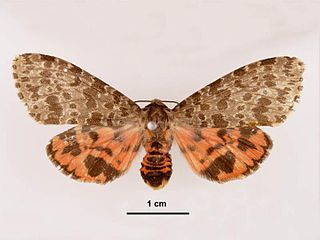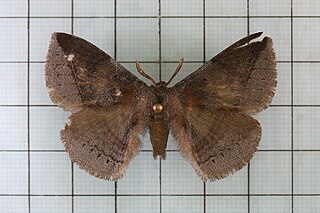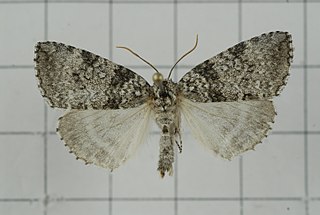
Olepa is a genus of moths in the family Erebidae. The genus was described by Watson in 1980. Most part of species occur in India and Sri Lanka, though one species was described from Israel.

Olepa schleini is a moth of the family Erebidae first described by Thomas J. Witt, Günter C. Müller, Vasiliy D. Kravchenko, Michael A. Miller, Axel Hausmann and Wolfgang Speidel in 2005. It is only known from the coastal regions of Israel, but is probably an alien species, as its food plant is not native to Israel. The species was discovered in 2005 and is named for the entomologist and sculptor Yosef Schlein. The larvae only feed on Ricinus communis, which is curious because this plants produces the natural insecticide ricin.
Syrastrenopsis is a genus of moths in the family Lasiocampidae. The genus was erected by Karl Grünberg in 1914.
Bastilla tahitiensis is a moth of the family Noctuidae first described by Orhant in 2002. It is endemic to Tahiti and Moorea.
Hervé de Toulgoët was a French entomologist. He specialised in moths of the families Arctiidae and Zygaenidae. He also studied the beetle genus Carabus. He was written about by Paul Thiaucourt and Jocelyne Navatte.

Olepa ricini is a moth of the family Erebidae first described by Johan Christian Fabricius in 1775. It is found in Bangladesh, India, Nepal, and Sri Lanka. An older treatment placed the species in the genus Pericallia.
Olepa clavatus is a moth of the family Erebidae first described by Charles Swinhoe in 1885. It is found in India.
Olepa toulgoeti is a moth of the family Erebidae first described by Orhant in 1986. It is found in southern India.
Olepa koslandana is a moth of the family Erebidae first described by Orhant in 1986. It is found in India and Sri Lanka.
Olepa anomi is a moth of the family Erebidae first described by Orhant in 1986. It is found in Sri Lanka.
Olepa kakatii is a moth of the family Erebidae first described by Orhant in 2000. It is found in north-eastern India and Assam.

Olepa ocellifera is a moth of the family Erebidae first described by Francis Walker in 1855. It is found in India and Sri Lanka.

Olepa coromandelica is a moth of the family Erebidae. It was found in India in the 19th century on the Coromandel Coast. No modern specimens have been collected later. Probably, it is extinct now.

Ganisa is a genus of moths of the family Eupterotidae first described by Francis Walker in 1855.
Agrisius dubatolovi is a moth of the subfamily Arctiinae. It is found in Thailand.
Agrotis viettei is a moth of the family Noctuidae. It is found in Réunion.
Olepa neumuthi is a species of moth the family Erebidae. It is endemic to the Indochinese region and was discovered in 2011 by the German entomologist Hans Helmuth Neumuth (1942-2013) and classified by the French entomologist Georges E.R.J. Orhant.

Parapsestis is a genus of moths belonging to the subfamily Thyatirinae of the Drepanidae.
Parapsestis odilei is a moth in the family Drepanidae. It was described by Orhant in 2006. It is found in Thailand.






